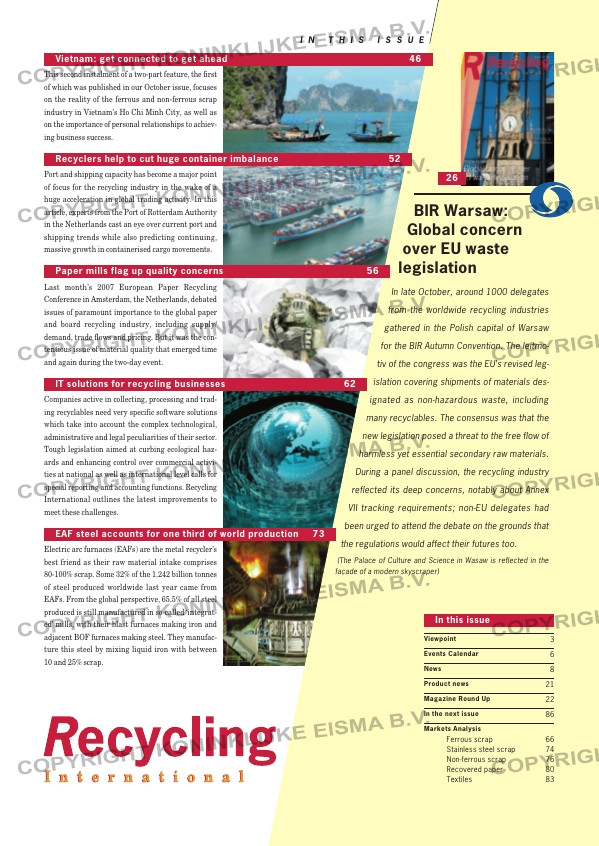Page 5 from: November 2007

This second instalment of a two-part feature, the first
of which was published in our October issue, focuses
on the reality of the ferrous and non-ferrous scrap
industry in Vietnam’s Ho Chi Minh City, as well as
on the importance of personal relationships to achiev-
ing business success.
In late October, around 1000 delegates
from the worldwide recycling industries
gathered in the Polish capital of Warsaw
for the BIR Autumn Convention. The leitmo-
tiv of the congress was the EU’s revised leg-
islation covering shipments of materials des-
ignated as non-hazardous waste, including
many recyclables. The consensus was that the
new legislation posed a threat to the free flow of
harmless yet essential secondary raw materials.
During a panel discussion, the recycling industry
reflected its deep concerns, notably about Annex
VII tracking requirements; non-EU delegates had
been urged to attend the debate on the grounds that
the regulations would affect their futures too.
(The Palace of Culture and Science in Wasaw is reflected in the
façade of a modern skyscraper)
In this issue
Viewpoint 3
Events Calendar 6
News 8
Product news 21
Magazine Round Up 22
In the next issue 86
Markets Analysis
Ferrous scrap 66
Stainless steel scrap 74
Non-fer rous scrap 76
Recovered paper 80
Textiles 83
Vietnam: get connected to get ahead 46
26
I N T H I S I S S U E
Port and shipping capacity has become a major point
of focus for the recycling industry in the wake of a
huge acceleration in global trading activity. In this
article, experts from the Port of Rotterdam Authority
in the Netherlands cast an eye over current port and
shipping trends while also predicting continuing,
massive growth in containerised cargo movements.
Recyclers help to cut huge container imbalance 52
Companies active in collecting, processing and trad-
ing recyclables need very specific software solutions
which take into account the complex technological,
administrative and legal peculiarities of their sector.
Tough legislation aimed at curbing ecological haz-
ards and enhancing control over commercial activi-
ties at national as well as international level calls for
special reporting and accounting functions. Recycling
International outlines the latest improvements to
meet these challenges.
Electric arc furnaces (EAFs) are the metal recycler’s
best friend as their raw material intake comprises
80-100% scrap. Some 32% of the 1.242 billion tonnes
of steel produced worldwide last year came from
EAFs. From the global perspective, 65.5% of all steel
produced is still manufactured in so-called ‘integrat-
ed’ mills, with their blast furnaces making iron and
adjacent BOF furnaces making steel. They manufac-
ture this steel by mixing liquid iron with between
10 and 25% scrap.
EAF steel accounts for one third of world production 73
Last month’s 2007 European Paper Recycling
Conference in Amsterdam, the Netherlands, debated
issues of paramount importance to the global paper
and board recycling industry, including supply/
demand, trade flows and pricing. But it was the con-
tentious issue of material quality that emerged time
and again during the two-day event.
Paper mills flag up quality concerns 56
IT solutions for recycling businesses 62
BIR Warsaw:
Global concern
over EU waste
legislation
RI_002 Inhoud:Opmaak 1 08-11-2007 09:05 Pagina 5



